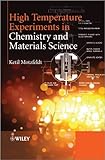High temperature experiments in chemistry and materials science / Ketil Motzfeldt.
Material type: TextPublisher number: EB00063687 | Recorded BooksPublisher: Chichester, West Sussex, United Kingdom : Wiley., 2013Description: 1 online resourceContent type:
TextPublisher number: EB00063687 | Recorded BooksPublisher: Chichester, West Sussex, United Kingdom : Wiley., 2013Description: 1 online resourceContent type: - text
- computer
- online resource
- 9781118457788 ( ePub)
- 1118457781 ( ePub)
- 9781118457764 (MobiPocket)
- 1118457765 (MobiPocket)
- 9781118457771 (Adobe PDF)
- 1118457773 (Adobe PDF)
- 9781118457795
- 111845779X
- 9781299188297
- 129918829X
- 541/.3687078 23
- QD515
- SCI013050
"The present text is centred around some central topics within high-temperature chemistry. It concerns the control and measurement of the basic properties"-- Provided by publisher.
Includes bibliographical references and index.
Machine generated contents note: Foreword vii Preface ix 1 Introduction to High-Temperature Research 1 2 Basic Design of Laboratory Furnaces 11 3 Temperature Measurements 55 4 Radiation Pyrometry 93 5 Refractory Materials in the Laboratory 129 6 Vacuum in Theory and Practice 177 7 High-Temperature Furnaces and Thermobalances 229 8 The Summing Up 267 Author Index 317 Subject Index 000 .
Description based on print version record and CIP data provided by publisher.
High Temperature Experiments in Chemistry and Materials Science; Contents; Foreword; Preface; Acknowledgements; 1 Introduction to High Temperature Research; Preamble; 1.1 The Basis of It All; 1.1.1 Photosynthesis; 1.1.2 The Role of Carbon; 1.2 High Temperatures; 1.2.1 Chemistry at Ambient Temperatures; 1.2.2 Chemistry at High Temperatures; 1.2.3 The Nitrogen Industry; 1.2.4 Iron and Steel; 1.3 Carbothermal Silicon and Aluminium; 1.3.1 Ferrosilicon and Silicon Metal; 1.3.2 The First Laboratory Furnace; 1.3.3 Carbothermal Aluminium; 1.3.4 More Laboratory Furnaces.
1.3.5 A Note on Chemical Thermodynamics1.4 Summary of Contents; Select Bibliography; 2 Basic Design of Laboratory Furnaces; Preamble; 2.1 Methods of Heating; 2.2 Materials; 2.2.1 Electric Conductors or Resistors; 2.2.2 Insulating Materials; 2.3 Basic Furnace Design; 2.3.1 Obtaining a Uniform Temperature; 2.3.2 Base Metal Wire; 2.3.3 The Stand and Auxiliaries; 2.3.4 Silicon Carbide; 2.3.5 Molybdenum Disilicide; 2.3.6 Oxide Resistors; 2.3.7 Noble Metals; 2.3.8 Molybdenum Wire; 2.3.9 Graphite; 2.4 Induction Heating; 2.4.1 Elementary Principles; 2.4.2 High Frequency Generators.
2.4.3 Some Laboratory Applications2.5 Power Input, Insulation and Cooling; 2.5.1 Power and Temperature; 2.5.2 Thermal Insulation; 2.5.3 Water Cooling; 2.6 Temperature Control; 2.6.1 Elementary Principles and Two-Position Control; 2.6.2 PID Control; 2.6.3 Power Regulators; 2.6.4 Sensing Elements for Control; 2.7 Electric Connections and Circuits; 2.7.1 General Rules; 2.7.2 Current-Carrying Capacity of Insulated Copper Wire; 2.7.3 Fail-Safe Protection Devices; References; 3 Temperature Measurements; Preamble; 3.1 Fundamentals of Temperature Measurement; 3.1.1 The Concept of Temperature.
3.1.2 The Thermodynamic Temperature Scale3.1.3 The Gas Thermometer and the Practical Temperature Scale; 3.1.4 History of the International Temperature Scales; 3.1.5 The International Temperature Scale of 1990 (ITS-90); 3.2 'Low-Temperature' Thermometers; 3.2.1 Liquid-in-Glass Thermometers; 3.2.2 Bimetallic Thermometers and Thermostats; 3.2.3 Semiconductor-Based Thermometers; 3.2.4 Resistance Thermometers; 3.3 Thermocouples; 3.3.1 Principles of Thermoelectricity; 3.3.2 Thermocouple Materials; 3.3.3 Base-Metal Thermocouples; 3.3.4 Noble-Metal Thermocouples.
3.3.5 Insulating Materials and Installation3.3.6 MIMS Thermocouples; 3.3.7 Thermocouples for Very High Temperatures; 3.3.8 The Cold Junction; 3.3.9 Extension and Compensating Wires; 3.3.10 Control and Calibration; 3.3.11 The Measurement of Small e.m.f.'s; 3.3.12 More about Thermoelectricity; 3.4 Literature; References; 4 Radiation Pyrometry; Preamble; 4.1 Basic Principles; 4.1.1 The Nature of Heat and Radiation; 4.1.2 Formation and Propagation; 4.1.3 The Concept of the Black Body; 4.1.4 Emission, Absorbtion and Kirchhoff's Law; 4.1.5 Total Radiation, Stefan and Boltzmann.
Physical Science
